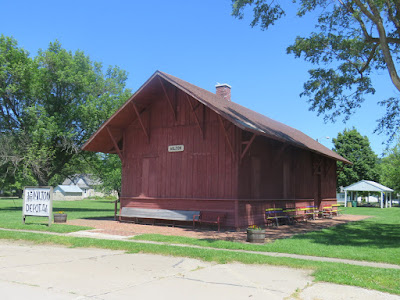Continuing
west along on secondary highways in the general direction of Omaha Nebraska…
To
those that think that Iowa is flat and that all you see is corn along the
roadside…this is a view of the southeastern part of the state on Iowa Hwy.
2. The view is expansive and there are
rolling hills and lots of trees too.
Yes…that is corn down in the valley!
Don’t
get me wrong… Iowa is indeed the #1 corn producing state in the USA. It produces 3 times more corn than Mexico! In 2014, Iowa produced 2,367,400,000 bushels
of corn, slightly more than the state of Illinois.
This is
the Burg Wagon Building in Farmington Iowa.
Lewis Burg, an immigrant from Bavaria, first worked in his brother’s
wagon works in Burlington Iowa. Then he
moved to Farmington and set up his own operation in 1865. In 1868 he had this two-story stone building
constructed. He had the largest wagon
works in town, doubling his production over the next 10 years. (There were at
least 2 other competitors!) Burg sold the building in 1892. The structure has been used for various
purposes over the years, with apartments being built on the 2nd
floor around the turn of the 20th Century.
This is
a beautiful building… I just love it!
Although various retail operations have occupied the first floor over
the years, it appears that it is vacant (or lived in) now. Note the bench, plants, table and chairs on
the roof over the sidewalk. Yikes…no
railings!
This is
the old Chicago, Burlington and Quincy combination railway depot in
Farmington. The tracks are long
gone. I was unable to determine when
this depot was constructed but I’m guessing it was in the late 1800s.
Farmington
was settled in 1833, following the Blackhawk War and about a dozen years before
Iowa became a state. The town was incorporated
in 1841. Farmington is the oldest village in Van Buren County and it was the
first county seat. By 1900, Farmington
had a population of 1,332 but today the village’s residents only total about
650.
Note:
· The Black Hawk War was a brief conflict in
1932 between the United States and Native Americans, led by Black Hawk, a Sauk
leader. The war erupted soon after Black
Hawk and a group of Sauks, Meskwakis, and Kickapoos, known as the "British
Band", crossed the Mississippi River into Illinois from Iowa Indian
Territory in April 1832. Black Hawk wanted to reclaim lands previously ceded
to the US Government. This was the last
Indian War fought east of the Mississippi River…
I noted
that one of the websites that I use to find or verify railroad depots and
related structures showed this depot being currently used as a residence. The mailbox probably cinches that fact.
One of
the sites that I use to locate depots and other railroad structures is
“Significant Extant Railroad/Railway Structures of North America. The website is at http://www.rrshs.org/Struct.index/strucindex.htm.
Farmington
is sure a quiet peaceful place today.
However by 1878, the town supported 1 printing office, 4 dry goods
stores, 2 drug stores, 3 grocery stores, 2 agencies, 3 hardware stores, a harness
shop, those 3 wagon shops, 2 blacksmith shops, a cigar manufacturer, 2 shoe
shops, 2 furniture houses, a grist mill, and a saw mill. The town also boasted 3 lawyers, 5 physicians,
and 2 Justices of the Peace serving 1,000 citizens.
This is
the former Chicago, Burlington and Quincy combination depot in Milton
Iowa. The community has preserved this
structure and it’s open for special events.
I found a history of Milton on-line and apparently the depot was built
at about the same time that the railroad came to town…ca. 1871. If the information is accurate, this depot is
about 145 years old! All rail service to
Milton came to an end in 1969.
The
town was founded in 1851 by settlers from Milton Delaware…hence the town’s
name. When the railroad came to town the
town experienced a growth spurt although it never had more than 913 residents. An interesting statistic is that in 1880
Milton had a population of 412. In 2014 the
town had 417 residents.
It’s
hard for us to imagine all of the activity and industry in towns like Milton
back in the 1800s… Except by rail, travel was slow and to some degree each
community had to be self-sustaining. In
1878, Milton had 2 drug stores, 5 dry goods stores, 3 hotels, a grocery store,
hardware store, cabinet shop, harness shop, shoe shop, 3 wagon shops, 3
blacksmith shops, 2 restaurants, an ice cream parlor, a photographer, a flour
mill, a saw mill, an axe handle factory and 2 brick kilns.
By
comparison, Milton seems very laid back these days. A number of Amish families moved into the
area in 1969, adding a bit of diversity.
I observed that one interesting shopping opportunity noted for the town
in the ‘Villages of Van Buren County’ website involved those modern day
settlers. (http://villagesofvanburen.com/directory.html?category=6)
That shopping opportunity is Milton Creamery. As per their website, “the Musser family
mixes fresh ingredients, art, and passion to create internationally award
winning cheese. Traditional Amish dairy
farmers produce milk used at Milton Creamery.
The cheese maker, Galen Musser, crafts each batch before hand-packing,
pressing and aging to perfection.” We
love cheese so it was too bad that we passed by the Creamery on a Sunday holiday weekend. To learn more about the
Milton Creamery, go to http://www.miltoncreamery.com/.
Just
click on any of the photos to enlarge them…
Thanks
for stopping by for a visit!
Take
Care, Big Daddy Dave






2.3 billion bushels is a lot of corn- we saw a lot driving across Kansas yesterday.
ReplyDelete